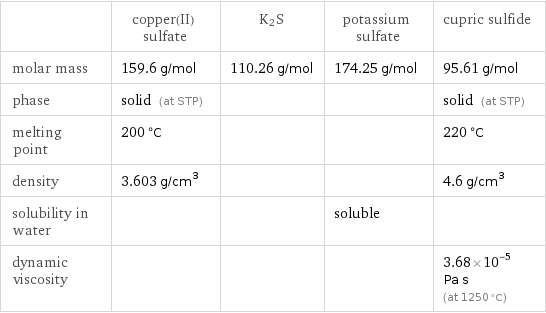Input interpretation

CuSO_4 copper(II) sulfate + K2S ⟶ K_2SO_4 potassium sulfate + CuS cupric sulfide
Balanced equation

Balance the chemical equation algebraically: CuSO_4 + K2S ⟶ K_2SO_4 + CuS Add stoichiometric coefficients, c_i, to the reactants and products: c_1 CuSO_4 + c_2 K2S ⟶ c_3 K_2SO_4 + c_4 CuS Set the number of atoms in the reactants equal to the number of atoms in the products for Cu, O, S and K: Cu: | c_1 = c_4 O: | 4 c_1 = 4 c_3 S: | c_1 + c_2 = c_3 + c_4 K: | 2 c_2 = 2 c_3 Since the coefficients are relative quantities and underdetermined, choose a coefficient to set arbitrarily. To keep the coefficients small, the arbitrary value is ordinarily one. For instance, set c_1 = 1 and solve the system of equations for the remaining coefficients: c_1 = 1 c_2 = 1 c_3 = 1 c_4 = 1 Substitute the coefficients into the chemical reaction to obtain the balanced equation: Answer: | | CuSO_4 + K2S ⟶ K_2SO_4 + CuS
Structures

+ K2S ⟶ +
Names

copper(II) sulfate + K2S ⟶ potassium sulfate + cupric sulfide
Equilibrium constant
![Construct the equilibrium constant, K, expression for: CuSO_4 + K2S ⟶ K_2SO_4 + CuS Plan: • Balance the chemical equation. • Determine the stoichiometric numbers. • Assemble the activity expression for each chemical species. • Use the activity expressions to build the equilibrium constant expression. Write the balanced chemical equation: CuSO_4 + K2S ⟶ K_2SO_4 + CuS Assign stoichiometric numbers, ν_i, using the stoichiometric coefficients, c_i, from the balanced chemical equation in the following manner: ν_i = -c_i for reactants and ν_i = c_i for products: chemical species | c_i | ν_i CuSO_4 | 1 | -1 K2S | 1 | -1 K_2SO_4 | 1 | 1 CuS | 1 | 1 Assemble the activity expressions accounting for the state of matter and ν_i: chemical species | c_i | ν_i | activity expression CuSO_4 | 1 | -1 | ([CuSO4])^(-1) K2S | 1 | -1 | ([K2S])^(-1) K_2SO_4 | 1 | 1 | [K2SO4] CuS | 1 | 1 | [CuS] The equilibrium constant symbol in the concentration basis is: K_c Mulitply the activity expressions to arrive at the K_c expression: Answer: | | K_c = ([CuSO4])^(-1) ([K2S])^(-1) [K2SO4] [CuS] = ([K2SO4] [CuS])/([CuSO4] [K2S])](../image_source/d5cff718fdba892a4d3cceb59b36a514.png)
Construct the equilibrium constant, K, expression for: CuSO_4 + K2S ⟶ K_2SO_4 + CuS Plan: • Balance the chemical equation. • Determine the stoichiometric numbers. • Assemble the activity expression for each chemical species. • Use the activity expressions to build the equilibrium constant expression. Write the balanced chemical equation: CuSO_4 + K2S ⟶ K_2SO_4 + CuS Assign stoichiometric numbers, ν_i, using the stoichiometric coefficients, c_i, from the balanced chemical equation in the following manner: ν_i = -c_i for reactants and ν_i = c_i for products: chemical species | c_i | ν_i CuSO_4 | 1 | -1 K2S | 1 | -1 K_2SO_4 | 1 | 1 CuS | 1 | 1 Assemble the activity expressions accounting for the state of matter and ν_i: chemical species | c_i | ν_i | activity expression CuSO_4 | 1 | -1 | ([CuSO4])^(-1) K2S | 1 | -1 | ([K2S])^(-1) K_2SO_4 | 1 | 1 | [K2SO4] CuS | 1 | 1 | [CuS] The equilibrium constant symbol in the concentration basis is: K_c Mulitply the activity expressions to arrive at the K_c expression: Answer: | | K_c = ([CuSO4])^(-1) ([K2S])^(-1) [K2SO4] [CuS] = ([K2SO4] [CuS])/([CuSO4] [K2S])
Rate of reaction
![Construct the rate of reaction expression for: CuSO_4 + K2S ⟶ K_2SO_4 + CuS Plan: • Balance the chemical equation. • Determine the stoichiometric numbers. • Assemble the rate term for each chemical species. • Write the rate of reaction expression. Write the balanced chemical equation: CuSO_4 + K2S ⟶ K_2SO_4 + CuS Assign stoichiometric numbers, ν_i, using the stoichiometric coefficients, c_i, from the balanced chemical equation in the following manner: ν_i = -c_i for reactants and ν_i = c_i for products: chemical species | c_i | ν_i CuSO_4 | 1 | -1 K2S | 1 | -1 K_2SO_4 | 1 | 1 CuS | 1 | 1 The rate term for each chemical species, B_i, is 1/ν_i(Δ[B_i])/(Δt) where [B_i] is the amount concentration and t is time: chemical species | c_i | ν_i | rate term CuSO_4 | 1 | -1 | -(Δ[CuSO4])/(Δt) K2S | 1 | -1 | -(Δ[K2S])/(Δt) K_2SO_4 | 1 | 1 | (Δ[K2SO4])/(Δt) CuS | 1 | 1 | (Δ[CuS])/(Δt) (for infinitesimal rate of change, replace Δ with d) Set the rate terms equal to each other to arrive at the rate expression: Answer: | | rate = -(Δ[CuSO4])/(Δt) = -(Δ[K2S])/(Δt) = (Δ[K2SO4])/(Δt) = (Δ[CuS])/(Δt) (assuming constant volume and no accumulation of intermediates or side products)](../image_source/0b40fc90479cf3d7c7536e33a0c0b271.png)
Construct the rate of reaction expression for: CuSO_4 + K2S ⟶ K_2SO_4 + CuS Plan: • Balance the chemical equation. • Determine the stoichiometric numbers. • Assemble the rate term for each chemical species. • Write the rate of reaction expression. Write the balanced chemical equation: CuSO_4 + K2S ⟶ K_2SO_4 + CuS Assign stoichiometric numbers, ν_i, using the stoichiometric coefficients, c_i, from the balanced chemical equation in the following manner: ν_i = -c_i for reactants and ν_i = c_i for products: chemical species | c_i | ν_i CuSO_4 | 1 | -1 K2S | 1 | -1 K_2SO_4 | 1 | 1 CuS | 1 | 1 The rate term for each chemical species, B_i, is 1/ν_i(Δ[B_i])/(Δt) where [B_i] is the amount concentration and t is time: chemical species | c_i | ν_i | rate term CuSO_4 | 1 | -1 | -(Δ[CuSO4])/(Δt) K2S | 1 | -1 | -(Δ[K2S])/(Δt) K_2SO_4 | 1 | 1 | (Δ[K2SO4])/(Δt) CuS | 1 | 1 | (Δ[CuS])/(Δt) (for infinitesimal rate of change, replace Δ with d) Set the rate terms equal to each other to arrive at the rate expression: Answer: | | rate = -(Δ[CuSO4])/(Δt) = -(Δ[K2S])/(Δt) = (Δ[K2SO4])/(Δt) = (Δ[CuS])/(Δt) (assuming constant volume and no accumulation of intermediates or side products)
Chemical names and formulas

| copper(II) sulfate | K2S | potassium sulfate | cupric sulfide formula | CuSO_4 | K2S | K_2SO_4 | CuS Hill formula | CuO_4S | K2S | K_2O_4S | CuS name | copper(II) sulfate | | potassium sulfate | cupric sulfide IUPAC name | copper sulfate | | dipotassium sulfate |
Substance properties

| copper(II) sulfate | K2S | potassium sulfate | cupric sulfide molar mass | 159.6 g/mol | 110.26 g/mol | 174.25 g/mol | 95.61 g/mol phase | solid (at STP) | | | solid (at STP) melting point | 200 °C | | | 220 °C density | 3.603 g/cm^3 | | | 4.6 g/cm^3 solubility in water | | | soluble | dynamic viscosity | | | | 3.68×10^-5 Pa s (at 1250 °C)
Units
